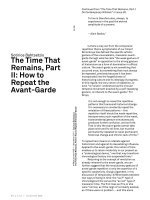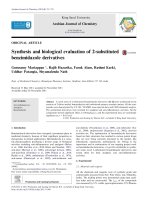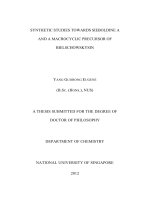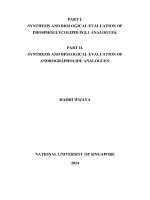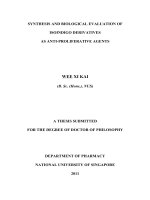Part 1 total synthesis and biological evaluation of antillatoxin and fragments part II synthetic studies towards the total synthesis of cytochalasans and tuberostemonine
Bạn đang xem bản rút gọn của tài liệu. Xem và tải ngay bản đầy đủ của tài liệu tại đây (15.36 MB, 293 trang )
PART I
TOTAL SYNTHESIS AND BIOLOGICAL EVALUATION
OF ANTILLATOXIN AND FRAGMENTS
PART II
SYNTHETIC STUDIES TOWARDS THE TOTAL
SYNTHESIS OF CYTOCHALASANS AND
TUBEROSTEMONINE
APPENDIX
SILICON-ASSISTED PROPARGYLIC TRANSFER TO
ALDEHYDES
LEE KIEW CHING
NATIONAL UNIVERSITY OF SINGAPORE
2005
PART I
TOTAL SYNTHESIS AND BIOLOGICAL EVALUATION
OF ANTILLATOXIN AND FRAGMENTS
PART II
SYNTHETIC STUDIES TOWARDS THE TOTAL
SYNTHESIS OF CYTOCHALASANS AND
TUBEROSTEMONINE
APPENDIX
SILICON-ASSISTED PROPARGYLIC TRANSFER TO
ALDEHYDES
LEE KIEW CHING
(B.Sc. (Hons), University of Malaya)
(M.Sc. National University of Malaysia)
A THESIS SUBMITTED FOR THE DEGREE OF
DOCTOR OF PHILOSOPHY
DEPARMENT OF CHEMISTRY
NATIONAL UNIVERSITY OF SINGAPORE
2005
ACKNOWLEDGEMENTS
I would like to express my deepest gratitude to my supervisor, Professor Loh Teck
Peng for his patience, guidance and advice throughout this course of study.
I would like to express my appreciation to my fellow researchers Dr. Wong Chek
Ming for his help and discussion during the project; Miss Koo Yanting, Miss Joyce
Chang Wei Wei and Mr Chow Yeong Shenq for helping me in preparation of the
starting materials. In addition, I also like to thank all other members (present and past)
in Prof. Loh’s group for their contribution throughout the years.
I also wish to express my sincere thanks to Dr Chua Guan Leong for proof reading
my thesis.
Thanks are also due to National University of Singapore for its generous financial
support. Sincere thanks go to Mdm Wong Lai Kwai and Miss Lai Hui Ngee for the
MS support; also to Mdm Han Yan Hui and Miss Ler Peggy for the NMR support.
Finally, I would like to thank my family for their prayers, support, and encouragement
for the past three years.
ii
TABLE OF CONTENTS
Acknowledgements i
Table of Contents ii
Summary iv
Abbreviations ix
Part I:
Chapter 1: Total Synthesis and Biological Evaluation of
Antillatoxin and Fragments
1.1 Historical Background 2
1.2 Previous Synthetic Studies 4
1.3 Our Retrosynthetic Analysis of Antillatoxin 11
1.4 Results and Discussion 15
1.5 Biological Evaluation of Antillatoxin and Fragments
Using Zebrafish Embryo 30
1.6 Conclusion 44
1.7 Experimental 45
Part II
Chapter 2: Synthetic Studies Towards the Total Synthesis
of Cytochalasans
2.1 Introduction 117
2.2 Biological Activities 119
2.3 Previous Synthetic Works 122
2.4 Our Synthetic Plan 127
iii
2.5 Results and Discussions 134
2.6 Conclusion 161
2.7 Future works 161
2.8 Experimental 163
Chapter 3: Synthetic Studies Towards the Total Synthesis of
Tuberostemonine
3.1 Introduction 199
3.2 Previous Synthetic Works 202
3.3 Our Synthetic Strategy 212
3.4 Results and Discussions 217
3.5 Conclusion 225
3.6 Future Works 226
3.7 Experimental 227
Appendix: Silicon-Assisted Propargylic Transfer To Aldehydes
A.1 Introduction 251
A.2 Propargylic Alcohols as Intermediates in Organic Synthesis 252
A.3 Applications of Allenic Alcohols 255
A.4 Results and Discussion 260
A.5 Conclusion 267
A.6 Experimental Section 269
List of Publications 279
iv
SUMMARY
Part I
The total synthesis of natural (4R, 5R)-antillatoxin 4b and its analogue (4S, 5S)-
antillatoxin 4c has been achieved in 9 steps (from bromide 43 and aldehyde 41 -
strategy 2) in 23% overall yield. Our strategy provides practical and easy entry into
key intermediates and analogues. Notable features of this synthesis include the
indium-mediated allylation of a secondary allylic bromide with aldehyde in aqueous
media, and an oxidation-reduction sequence to control the two chiral centres at C
4
and
C
5
. Especially noteworthy is the convergent nature of this synthetic strategy and the
incorporation of all the necessary functionalities in the early stages of the synthesis.
The procedure developed here can be used for large scale synthesis of other
biologically interesting natural products.
O
N
N
H
H
N
O
O
O
(S)
O
(S)
(4S, 5S)-Antillatoxin (4c)
5
4
O
N
N
H
H
N
O
O
O
O
(4R, 5R)-Antillatoxin (4b)
5
4
17
15'
1
2
3
6
7
8
9
10
11
12
13
14
15 16
1'
2'
3'
4'
5'
6'
7'
8'
9'
10'
11'
12'
13'
14'
(R)
(R)
HO
(R)
(R)
HO
66b
Effects: notochord defect,
vascular system
Effects: heart, notochord, brain,
hatching gland, vascular system
v
Screening of this library of simpler fragments obtained during the process of
the total synthesis compounds has resulted in the discovery of other potent
compounds. This simple screen utilizing zebrafish embryos has resulted in the
discovery of bioactive fragments (4R, 5R)-66b which display similar behavior as (4R,
5R)-antillatoxin. These interesting results provide further evidence on the ease and
usefulness of zebrafish embryos as a simple tool for fast biological evaluation in drug
discovery research.
Part II
In Chapter 2, synthetic studies towards the total synthesis of cytochalasans is
reported. Retrosynthetic analysis of cytochalasans gives the key intermediate 36 with
a bromine substituent at the C-9 position. Key intermediate 36 was envisaged to be
constructed from a Lewis acid catalyzed intermolecular Diels-Alder reaction of diene
32 and dienophile 33.
OHC
Br
OR
2
R
3
O
OHC
Br
OR
2
NH
R
1
R
OR
2
CHOBr
OR
3
+
HO OH
CHO
34
33
32
47
53
MLn*
MLn* = BF
3
.OEt
2
,
SnCl
4
or chiral
Lewis acid
H H
N
O
R
H
X
9
X = O or C
R = Pr
i
, aspochalasins
R = Ph, cytochalasins
R = Indole, chaetoglobosins
10
36
9
10
9
vi
We managed to build the desired six-membered cyclohexane ring system in
the key fragment 36 with the correct stereochemistry, which is the core ring skeleton
found in the cytochalasans class of natural products. By treating the crude aldehyde
81 and diene 23 with BF
3
.OEt
2
in dichoromethane, we obtained cycloadduct 88a as a
colorless oil in 22% yield after 16 hours of reaction at -60 °C. In the reaction, we
found that only the minor (E)-isomer went through the normal [4+2] Diels-Alder
cycloaddition reaction.
23
81
ratio 4(
Z
):1(
E
)
MeO
2
C
+
CHO
EtO
2
C
BF
3
.OEt
2
CH
2
Cl
2
-78 °C to -60 °C
CO
2
Et
CO
2
Me
88a
OBn
CHO
OBn
22% (91:9)
The regiochemistry and relative stereochemistry of the cycloadducts 88a were
elucidated by
1
H NMR,
13
C (DEPT), COSY, NOESY, HMQC and HMBC as depicted
in Figure 2-10. The stereochemistry of the products suggests that due to the secondary
orbital interaction, the Diels-Alder reaction had proceeded via an endo transition state
giving product 88a.
MeO
2
C
CO
2
Et
BnO
O
H
OHC
EtO
2
C
CO
2
Me
OBn
endo transition state
88a
vii
In Chapter 3, the synthetic studies towards the total synthesis of
tuberostemonine is reported. Our key step relies on the intermolecular Diels-Alder
reaction between diene 55 and dienophile 56 to construct ring B. An amino group
would be introduced to the ring system through Curtius rearrangement and followed
by reductive amination to construct the pyrrolidine ring D. Finally, closure of the
seven-membered ring C was achieved by the conversion of the protecting group
followed by a S
N
2 reaction on the amino group.
OHC
OR
1
N
O
H
H
H
O
OR
1
H
OR
2
CO
2
Et
H
OR
1
O
R
3
O
O
TIPSO
A
B
C
D
+
56
49
54
55
OR
2
R
3
O
TIPSO
71
N
H
O
H
H
H
O
OR
1
OR
2
D
50
O
H
O
OR
2
NH
2
H
O
OR
1
51
O
H
O
OR
2
COOH
H
O
OR
1
A
B
The core ring B was planned to be achieved from diene 55 and dienophile 56.
However, no desired products were obtained. Further investigation with aldehyde-
ester 79 as dienophile, only the hetero-Diels-Alder product 80 was obtained from the
reaction mixture. Exploration with dienophile 82 afforded the mixture of normal
Diels-Alder cycloadduct 83 and hetero-Diels-Alder product 84. Even though
cycloadduct 83 is not the desired product for the total synthesis of tuberostemonine,
viii
this finding will still be useful in other synthesis which require more complicated
diene such as diene 55.
82
MeO
2
C
EtO
2
C
+
O
TIPSO
TBDPSO
CHO
CO
2
Me
CHO
CO
2
Et
O
TIPSO
O
TBDPSO
CO
2
Et
CO
2
Me
major
84
55
79
EtO
2
C
BF
3
.OEt
2
CH
2
Cl
2
-78 °C to -60 °C
O
TIPSO
TBDPSO
CHO
O
TIPSO
O
TBDPSO
CO
2
Et
hetero product only
77%
80
35% combined yield
ratio 83:84 (5:1)
minor (76:24)
83
ix
INDEX OF ABBREVIATIONS
! chemical shift
((( sonication
" reflux
ºC degree centrigrade
Ac acetyl
AcOH acetic acid
AIBN azo-bis-isobutyronitrile
Alloc allyloxycarbonyl
Ala alanine
aq. aqueous
9-BBN 9-borabicyclo[3.3.1]nonane
Bn benzyl
BOC tert-butoxycarbonyl
BOP benzotriazol-1-yloxytris (dimethylamino) phosphonium
hexafluorophosphate
brs broad singlet
Bz benzoyl
t-bu tert-butyl
cacld calculated
cat catalytic
Cbz benzyloxycarbonyl
CDCl
3
deuterated chloroform
COSY correlated spectroscopy
Cp cyclopentadienyl
CSA camphorsulfonic acid
CH
2
Cl
2
dichoromethane
CHCl
3
chloroform
cm
-1
inverse centimeter
cyc cyclohexane; cyclohexenyl
d doublet
DABCO 1,4-diazabicyclo[2.2.2]octane
x
dba dibenzylidene acetone
DBU 1,8-diazabicyclo[5.4.0]undec-7-ene
DCC 1,3-dicyclohexylcarbodiimide
dd doublets of doublet
de diastereomeric excess
DIBAL diisobutylaluminium hydride
DIEA diisopropylethylamine
DMAP 4-(N,N-dimethylamino)pyridine
DMF dimethylformamide
DMP Dess-Martin periodinane
DMSO dimethyl sulfoxide
DPPA diphenylphosphoryl azide
dt doublets of triplet
dq doublets of quartet
EDC 1-ethyl-3-(3-dimethylaminopropyl) carbodiimide hydrochloride
ee enantiomeric excess
EI electron impact ionization
equiv. equivalent
ESI electronspray ionization
Et ethyl
ether diethyl ether
Et
3
N triethylamine
EtOAc ethyl aceate
EtOH ethanol
FAB fast atomic bombardment
Fmoc 9-fluorenylmethyl
FTIR Fourier transform infrared spectroscopy
Gly glycine
g gram
h hour
H hydrogen
Hex hexane
HMBC heteronuclear multiple bond correlation
HMPA hexamethylphosphoramide
xi
HMQC heteronuclear multiple quantum correlation
HOBt 1-hydroxybenzotriazole
HRMS high resolution mass spectroscopy
Hz Hertz
IR infrared
i-Pr isopropyl
J coupling constants
kg kilogram
LDA lithium diisopropylamide
LiHMDS Lithium hexamethyl disilazide
M concentration (mol/dm
-3
)
M
+
parent ion peak (mass spectrum)
m multiplet
m-CPBA meta-chloroperoxybenzoic acid
Me methyl
MEM 2-methoxyethoxy methyl
MeOH methanol
mg milligram
MHz Megahertz
min minute
mmol millimoles
mol moles
MPM p-methoxyphenyl methyl
MS mass spectrum
Ms methanesulfonyl
N concentration (normality)
NBS N-bromosuccinimide
n-Bu n-butyl
NMR nuclear magnetic resonance
NOE nuclear overhauser effect
NOESY nuclear overhauser enhancement spectroscopy
obsd. observed
OTf trifluoromethanesulfonate
p page
xii
PBr
3
phophorus tribromide
PCC pyridinium chlorochromate
Pd palladium
Pd(PPh
3
)
4
tetrakis(triphenylphosphine)palladium(0)
Ph phenyl
ppm parts per million
Py pyridine
PyBrOP bromotripyrrolidinophosphonium hexafluorophosphate
q quartet
rt. room temperature
RBF round bottom flask
R
f
retention factor
s singlet
sat. saturated
t triplet
TBAF tetrabutylammonium fluoride
TBDMS tert-butyldimethyl silyl
TBDPS tert-butyldiphenyl silyl
t-BOC tert-butoxycarbonyl
t-Bu tert-butyl
td triplets of doublet
TFA trifluoroacetic acid
THF tetrahydrofuran
THP tetrahydropyran
TIPS triisopropyl silyl
TLC thin layer chromatography
TMSCl trimethylsilyl chloride
TPAP tetrapropylammonium perruthenate
Troc 2,2,2-trichloroethoxycarbonyl
Ts p-toluenesulfonyl
Val valine
vol volume
PART I
Chapter 1
Total Synthesis and
Biological Evaluation of
Antillatoxin and
Fragments
Chapter 1 : Total Synthesis of Antillatoxin
2
Part I
1.1 Historical Background
Marine cyanobacteriums are well known to be the rich source of structurally
unique neurotoxic secondary metabolites (eg. Brevetoxin B
1
(1), Curacin A
2
(2),
Barbamide
3
(3), Antillatoxin
4
(4b) etc as shown in Figure 1-1. Antillatoxin (4b) is one
of this marine toxins, isolated from the pantropical marine cyanobacterium Lyngbya
majuscula. It is a structurally novel lipopeptide with high degree of methylation and
without close parallel to any other known marine natural product. To date, it is one of
the most ichthyotoxic compounds isolated from marine sources. Its toxicity
measurements with goldfish recorded a LD
50
= 0.05 µg/mL, and it is only exceeded in
potency by brevetoxins (LD
50
= 0.003 µg/mL).
4,5
More recently, it has been shown to be neurotoxic in primary cultures of rat
cerebellar granule cells. In the latter study, morphological evidences of antillatoxin-
induced neurotoxicities included swelling of neuronal somata, thinning of neurites,
and blebbing of neurite membranes. Lactate dehydrogenase efflux monitoring
demonstrates that antillatoxin also induced a concentration-dependent cytotoxicity in
1
Lin, Y. -Y; Risk, M.; Ray, S. M.; Engen, D. V.; Clardy, J.; Golik, J.; James, J. C.; Nakanish, K. J.
Am. Chem. Soc. 1981, 103, 6773-6775.
2
Gerwick, W. H.; Proteau, P. J.; Nagle, D. G.; Hamel, E.; Blokhin, A.; Slate, D. L. J. Org. Chem.
1994, 59, 1243.
3
Orjala, J.; Gerwick, W. H. J. Nat. Prod. 1996, 59, 427.
4
Orjala, J.; Nagle, D. G.; Hsu, V. L.; Gerwick, W. H. J. Am. Chem. Soc. 1995, 117, 8281-8282.
5
(a) Berman, F. W.; Gerwick, W. H.; Murray, T. F. Toxicon 1999, 37, 1645-1648. (b) Wu, M.; Okino,
T.; Nogle, L. M.; Marquez, B. L.; Williamson, R. T.; Sitachitta, N.; Berman, F. W.; Murray, T. F.;
McGough, K.; Jacobs, R. et al. J. Am. Chem. Soc. 2000, 122, 12041-12042. (c) Lin, Y. -Y.; Risk, M.;
Ray, S. M.; Engen, D.V.; Clardy, J.; Golik, J.; James, J. C.; Nakanishi, K. J. Am. Chem. Soc. 1981,103,
6773.
Chapter 1 : Total Synthesis of Antillatoxin
3
Part I
cerebellar granule neurons. This neurotoxic response of antillatoxin was prevented by
either N-methyl-D-aspartate (NMDA) receptor antagonists or tetrodotoxin.
5,6
At the outset of this investigation, we were aware that only small amount of
antillatoxin had been isolated (1.3 mg, 0.07% of extract).
4
The successful outcome of
synthetic antillatoxin would aid in the production of enough quantities for detailed
biological evaluations.
The isolation of antillatoxin (4b) was reported by Gerwick and co-workers in
1995. Based on spectroscopic studies (1D and 2D NMR) and molecular modeling
using a dynamic simulated annealing protocol with the program XPLOR, they
deduced that the structure of antillatoxin as 4S, 5R configuration at C
4
and C
5
.
4
However, the structure was later revised to be 4R, 5R configuration by T. Shiori
7
and
J. Whites
8
groups.
6
(a) Li, W. I.; Berman, F. W.; Okino, T.; Yokokawa, F.; Shioiri, T.; Gerwick, W. H.; Murray, T. F.
Proc. Natl. Acad. Sci. U.S.A. 2001, 98, 7599-7604. (b) Li, W. I., Marquez, B. L., Okino, T., Yokokawa,
F., Shioiri, T., Gerwick, W. H., Murray, T. F. J. Nat. Prod. 2004, 67, 559-568.
7
(a) Yokokawa, F.; Shioiri. T. J. Org. Chem. 1998, 63, 8638-8639; (b) Yokokawa, F.; Fujiwara, H.;
Shioiri. T. Tetrahedron Lett. 1999, 40, 1915-1916. (c) Yokokawa, F.; Fujiwara, H.; Shioiri. T.
Tetrahedron 2000, 56, 1759-1775.
8
White, J. D.; Hanselmann, R.; Wardrop, D. J. Am. Chem. Soc. 1999, 121, 1106-1107.
Chapter 1 : Total Synthesis of Antillatoxin
4
Part I
S
N
H
H
H
OMe
N
O
N S
O
N
N
H
H
N
O
O
O
O
(4S, 5R)-Antillatoxin (4a)
(proposed)
5
4
O
N
N
H
H
N
O
O
O
O
(4R, 5R)-Antillatoxin (4b)
(revised)
5
4
Curacin A (2)
(anticancer)
Barbamide (3)
(molluscicidal)
Marine
Cyanobacterium
preclinical trial
O
O
O
O
O
H
O
H H
H
H
H
HO
H
H
H
O
O
O
O
OO
H
H
H H
H
H
H
A
B C
D
E
F
G
H
I
J
K
Brevetoxin B (1)
17
15'
1
2
3
6
7
8
9
10
11
12
13
14
15 16
1'
2'
3'
4'
5'
6'
7'
8'
9'
10'
11'
12'
13'
14'
(R)
(R)
(R)
(S)
OCH
3
CCl
3
Fig. 1-1
1.2 Previous Synthetic Studies
Being a molecule with unique biological activities and structural complexities,
antillatoxin has been the target of much synthetic endeavours. In 1998, Shioiri and co-
workers accomplished the first total synthesis of (4S, 5R)-antillatoxin with the
proposed structure 4a.
7a
7a
Yokokawa, F.; Shioiri. T. J. Org. Chem. 1998, 63, 8638-8639.
Chapter 1 : Total Synthesis of Antillatoxin
5
Part I
From their synthetic strategy, the complex molecule was constructed from two
subunits, a tripeptide unit and a diene fragment (Scheme 1-1, 1-2, 1-3). The tripeptide
unit 7 was prepared from alkaline saponification of 6 after a series of peptide coupling
reaction as shown in Scheme 1-1.
AllocHN
N
N
H
COOH
O
O
Alloc-(S)-Ala-(S)-MeVal-Gly-OEt
aq. LiOH
THF
95%
BOC-(S)-MeVal-Gly-OEt
1) CF
3
COOH, CHCl
3
2) Alloc-(S)-Ala-OH
BopCl, Et
3
N, CH
2
Cl
2
50%
DEPC, Et
3
N, DMF
86%
BOC-(S)-MeVal-OH
HClH-Gly-OEt
tripeptide 7
5
6
Scheme 1-1
Preparation of diene fragment 15a was achieved from alkyne 8 as the starting
material as shown in Scheme 1-2. The conjugated diene 9 was made from
hydroboration of alkyne 8 followed by Suzuki coupling with vinyl iodide. Evans’
chiral auxiliary was applied to generate the chiral centers at C
4
and C
5
of intermediate
10.
Chapter 1 : Total Synthesis of Antillatoxin
6
Part I
OH
1) MnO
2
, CH
2
Cl
2
2)
O
N
OH
CO
2
Me
OH
1) TPAP, NMO, 4ÅMS, CH
3
CN
2) (CF
3
CH
2
O)
2
P(O)CH
2
CO
2
Me
KHMDS, 18-crown-6, THF
74% (2 steps)
TESO
CO
2
Me
CF
3
CO
2
H
CH
2
Cl
2
66%
O
O
PhSeCH
2
Li
HMPA
THF
-78 ºC, 30 min
73%
O
O
SePh
Me
O
HB
O
I
OH
THF, reflux
1)
2)
aq. NaOH, THF, reflux
53%
O
O
Bn
N
O
O
O
Bn
n-Bu
2
BOTf.Et
3
N, CH
2
Cl
2
93% (2 steps)
1) LiOOH, aq. THF
2) MeI, KHCO
3
, DMF
60% (2 steps)
TESO OH
1) TESCl, Et
3
N,
DMAP, CH
2
Cl
2
2) DIBAL, CH
2
Cl
2
98% (2 steps)
8
9
10
11
12a
13a
14a
15a
Scheme 1-2
Lactone ring opening of 15a followed by allyl protecting and esterification
with tripeptide 7 gave the coupling product 16a. Oxidative elimination of the
phenylselenyl group, removal of allyl protecting groups and a final
macrolactamization gave the desired macrocycle antillatoxin 4a. (Scheme 1-3)
Chapter 1 : Total Synthesis of Antillatoxin
7
Part I
O
O
SePh
1) LiOH, aq. THF
2) allyl bromide, KHCO
3
, DMF
O
N
N
H
NHAlloc
O
O
O
AllylO
2
C
SePh
O
N
N
H
NHAlloc
O
O
O
AllylO
2
C
NaIO
4
aq. THF
93%
1) Pd(Ph
3
P)
4
,
morpholine, THF
2) DPPA, NaHCO
3
,
DMF, 0 ºC, 3 days
45%
O
N
N
H
H
N
O
O
O
O
(4S, 5R)-Antillatoxin (4a)
(proposed)
5
4
EDCI, DMAP, CH
2
Cl
2
15% (3 steps)
AllocHN
N
N
H
COOH
O
O
3)
15a
7 16a
17a
4
5
(R)
(S)
(R)
(S)
Scheme 1-3
Gerwick used NOE to confirm the stereochemistries of C
4
and C
5
. In our
group, we have been working on the synthesis of the isomers of C
4
and C
5
as NOE
studies of large rings is known to be unreliable.
9
Later, the NMR data of the synthetic (4S, 5R)-antillatoxin (4a) showed
significant differences from the natural product. These differences led to the
conclusion that the proposed structure does not accurately reflect the natural
antillatoxin that was isolated by Gerwick and co-workers. On the basis of the
assumption that the stereochemistries of the amino acids are secure, the
stereochemistry at C
4
and C
5
would be doubtful.
Furthermore, Whites and co-workers (1999)
8
reported their work on total
synthesis of (4S, 5R)-antillatoxin (4a). Their results were also consistent with the
results reported by T. Shioiri’s.
9
Cao Guo-Qiang, PhD Thesis, 1998.
Chapter 1 : Total Synthesis of Antillatoxin
8
Part I
Similar to Shioiri’s strategy, the tripeptide unit 21 was prepared from the
coupling of Cbz-protected N-methyl valine 18, methyl glycine and Troc-protected
alanine followed by LiOH saponification as shown in Scheme 1-4.
TrocHN
N
N
H
O
O
OMe
TrocHN
N
N
H
O
O
OH
Cbz
N
N
H
O
O
OMe
Cbz
N
OH
O
Gly-OMe, BroP,
(
i
-Pr)
2
NEt, CH
2
Cl
2
93%
1) H
2
, Pd/C MeOH
2) Troc-ala-OH, HATU, (
i
-Pr)
2
NEt, CH
2
Cl
2
74% (2 steps)
LiOH
THF
100%
18
19
20 21
Scheme 1-4
The aldehyde 25 was constructed from an optically pure methyl propionate 22
via a series of transformations as shown in Scheme 1-5.
S
S
O
S
S OTBS
Me
3
Si
OTBS
MeO OTBS
O
1) Me
3
SiCH
2
MgCl, CeCl
3
, THF
2) SiO
2
, CH
2
Cl
2
99% (2 steps)
2) BF
3
.OEt
2
, 0 ºC, 70%
(2 steps)
S S
BF
4
-
1)
CH
3
NO
2
, 0 ºC
o
-iodoxybenzoic acid (IBX)
(1M in DMSO)
THF
70%
22
23
24 25
Scheme 1-5
Coupling of aldehyde 25 with diene 27 (synthesized from alkyne 8) gave the
diene fragment 28. Esterification of 28 with tripeptide 21 with EDCI provided the
8
White, J. D.; Hanselmann, R.; Wardrop, D. J. Am. Chem. Soc. 1999, 121, 1106-1107.
Chapter 1 : Total Synthesis of Antillatoxin
9
Part I
coupling product 29. Removal of dithiane, oxidation followed by Troc-deprotection
and final macrolactamization led to antillatoxin 4a. (Scheme 1-6)
I
S
S
O
S
S
OH
O
N
N
H
NHTroc
O
O
O
75% (3 steps)
1) Zn, KH
2
PO
4
, THF
2) HATU, (i-Pr)
2
NEt,
DMF, 0 ºC,
O
N
N
H
H
N
O
O
O
(R)
O
(S)
(4S, 5R)-Antillatoxin (4a)
(proposed)
5
4
1) tripeptide 21, EDCI, DMAP, CH
2
Cl
2
S
S
O
N
N
H
NHTroc
O
O
O
COOH
2) MeI, CaCO
3
, MeCN-H
2
O
3) NaClO
4
, NaH
2
PO
4
, MeCH=CMe
2
, t-BuOH-H
2
O
1) Cp
2
ZrClH, THF
2) NBI
3) MeC!CMgBr,
Pd(PPh
3
)
4
,THF
1) Bu
3
Sn(Bu)CuCNLi
2
, THF, -50 ºC
2) MeOH, -50 ºC to -10
o
C, overnight
3) I
2
, Et
2
O, 0 ºC
t
-BuLi, THF, -78
o
C
60%
52% (3 steps)
68% (3 steps)
75%
60% (2 steps)
25
8
26 27
28
29
30
Scheme 1-6
From the analysis of the results obtained, Shioiri’s group
7b,7c
has finally
demonstrated that the correct structure should be (4R, 5R) anti configuration and not
the proposed (4S, 5R) syn configuration. This was further confirmed by their synthesis
of the (4R, 5R)-antillatoxin. In this new route, boron-mediated asymmetric aldol
reaction was employed to construct the anti-C
4
, C
5
configurations (Scheme 1-7). It
was found that the resulting product was identical to the natural antillatoxin by
comparing NMR, IR and optical rotation data. These series of work demonstrated that
7b,7c
(b)Yokokawa, F.; Fujiwara, H.; Shioiri. T. Tetrahedron Lett. 1999, 40, 1915-1916. (c) Yokokawa,
F.; Fujiwara, H.; Shioiri. T. Tetrahedron 2000, 56, 1759-1775.
Chapter 1 : Total Synthesis of Antillatoxin
10
Part I
the actual structure of antillatoxin should be revised to the (4R, 5R) configuration
instead of the proposed (4S, 5R) configuration.
OH
1) MnO
2
, CH
2
Cl
2
2)
N
SO
2
Mes
O
Ph
Me
Bn
O
c-Hex
2
BOTf, Et
3
N, CH
2
Cl
2
3) TESOTf
2,6-lutidine
CHCl
3
90% (3 steps)
O
O
MesOS
2
TESO Ph
Me
Bn
DIBAL
CH
2
Cl
2
100%
OHTESO
1) TPAP, NMO, 4Å MS, CH
3
CN
2) (CF
3
CH
2
O)
2
P(O)CH
2
CO
2
Me
KHMDS, 18-crown-6, THF
82% (2 steps)
TESO
CO
2
Me
CF
3
CO
2
H
CH
2
Cl
2
63%
O
O
PhSeCH
2
Li
HMPA
THF
O
O
SePh
1) LiOH, aq. THF
2) allyl bromide, KHCO
3
, DMF
3) tripeptide, EDCI, DMAP, CH
2
Cl
2
15% (4 steps)
O
N
N
H
NHAlloc
O
O
O
AllylO
2
C
SePh
O
N
N
H
NHAlloc
O
O
O
AllylO
2
C
NaIO
4
aq. THF
93%
1) Pd(Ph
3
P)
4
, morpholine, THF
2) DPPA, NaHCO
3
, DMF
0 ºC, 3 days
45%
O
N
N
H
H
N
O
O
O
O
(4R, 5R)-Antillatoxin (4b)
(revised)
5
4
9
31
12b
13b
14b
15b
16b
17b
5
4
(R)
(R)
(R)
(R)
Scheme 1-7
Although White’s and Shioiri’s group have successfully synthesized
antillatoxin, their synthetic routes are still long and cumbersome. Our strategy is to
devise a short and efficient synthetic route to antillatoxin. Hopefully our synthetic
route to antillatoxin will provide enough material for chemical and pharmacological
Chapter 1 : Total Synthesis of Antillatoxin
11
Part I
evaluation. With this in mind, our group embarked on the total synthesis of
antillatoxin and its analogues.
1.3 Our Retrosynthetic Analysis of Antillatoxin
Our retrosynthetic strategy of (4R, 5R)-antillatoxin 4b is outlined in Scheme
1-8. Disconnection of the macrocycle ring using the macrolactamization strategy will
give rise to precursor 32. Retrosynthetic cleavage of the ester bond will lead to two
key intermediates, the left wing fragment 33 and right wing fragment 34.
O
N
N
H
H
N
O
O
O
(R)
O
(R)
4b
O
N
N
H
COOH
H
N
R'
O
O
N
N
H
NHR'
O
O
O
32
Macrolactamization
esterification
+
Left Wing Fragment 33
(R)
(R)
HO
Right Wing Fragment 34
ROOC
RO
4
5
4
5
Scheme 1-8
